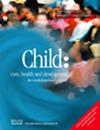Barriers and Facilitators for Physical Activity and Sedentary Behaviour Among Toddlers and Preschoolers Living in Poverty: Insights From Primary Caregivers in Mexico
Abstract
Background
The first 5 years of life set the stage for physical and mental development in adulthood. The practice of physical activity (PA) benefits this process. However, literature on PA in toddlers/preschoolers is scarce, especially among populations living in poverty. To characterise PA and explore the barriers and facilitators associated with the practice of PA and sedentary behaviour in young children (0–5 years of age) who live in poverty in Mexico.
Methods
We carried out 24 semi-structured interviews with primary caregivers (PCs) of children < 5 years old in two states of Mexico (Yucatán and Morelos) (n = 24). A thematic analysis was undertaken to analyse the data based on a socio-ecological model of PA. Thus, the codes were grouped into four main groups: (1) the importance and meaning of childhood PA and its perceived benefits; (2) family dynamics; (3) types of activities in which toddlers and preschoolers engage—including their frequency, timing, locations, and whether they participate alone or with others; and (4) perceived barriers and facilitators to children's PA.
Results
In this sample of the population living in poverty, it was found that most respondents identified PA as a healthy practice for toddler/preschool children. However, there was a low level of PA promotion by PCs. Differences in PA were identified between boys and girls (within the family and cultural level). At the environmental level, the lack of accessible, free, and safe spaces for children to practice PA was pointed out by PCs. Finally, the PCs associated sedentary behaviour with children's personalities, as well as the use of technological devices (such as cell phones and tablets). Screen time was also perceived as part of the child's educational skills for the future. Informants reported that children spend extended periods (> 3 h) of time in front of screens (cell phone and/or TV).
Conclusion
Barriers and facilitators were identified at various levels of the socioecological model, which should be considered to promote PA from an early age. Addressing these factors can help reduce physical inactivity among toddlers/preschoolers in socioeconomically disadvantaged contexts, ultimately enhancing their physical and mental development throughout their lives.
Summary
- There is scarce evidence about factors associated with the practice of PA or movement among toddlers and preschoolers who live in low-income homes, where overcrowded conditions and unstimulating physical and social environments limit PA.
- In low-resource contexts, lack of time to interact with the child to promote PA, lack of safe spaces for children's PA, and lack of information about recommendations and benefits on childhood PA were reported among primary caregivers of children under 5 years.
- There are perceptions that physical inactivity is natural for girls, or that use of devices such as cell phones or tablets is considered safe indoors and seen as educational for the child’s future among families living in poverty.
- Research and promotion about childhood PA requires socio-ecological interventions, especially in disadvantaged settings and specific populations (e.g., indigenous).
- Policies must consider the promotion of toddlers and preschoolers PA in their designs since this stage is likely to have a considerable impact on their future compared with adults.

 求助内容:
求助内容: 应助结果提醒方式:
应助结果提醒方式:


